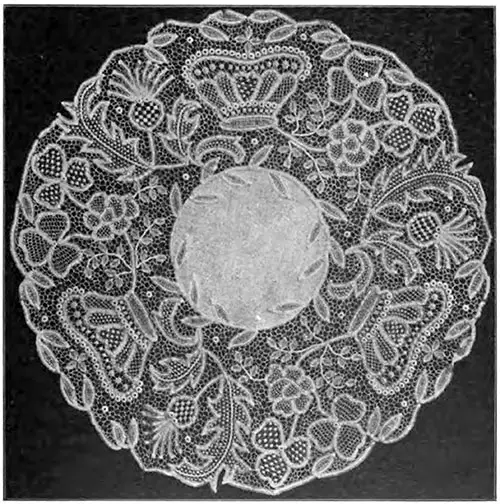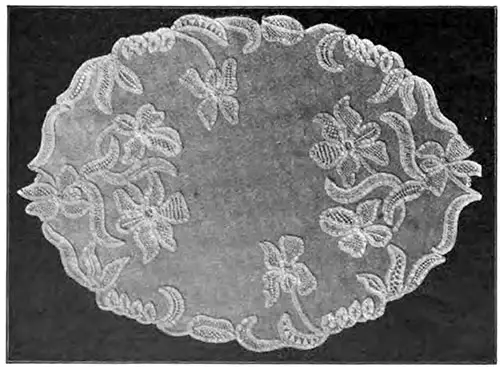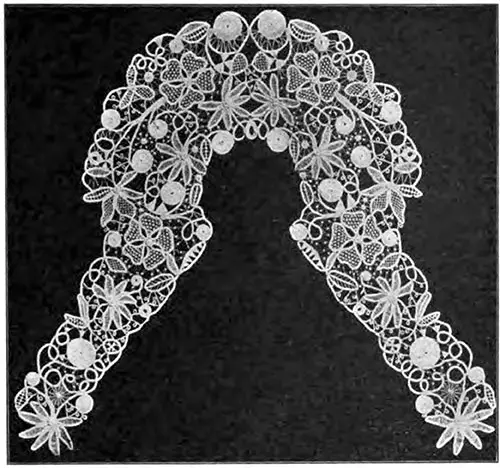Making Novel Laces - January 1904

The making of lace is always a fascinating occupation, whether for profit or pleasure. Select Good designs along with using the best materials for the work. Then, if careful artistry and patience are combined, the result will undoubtedly be gratifying.
In these days there are many ways to use these hand-made laces. The addition of a little, well-made lace of good design will give a simple new gown such a beautiful finish and foreign air as to lift it entirely out of the ranks of the commonplace.
Moreover, in the home, there is no end to the lovely touches one can give to almost every room with lace.
The tea-table is a natural field for such work, and the dainty doilies or the elaborate luncheon sets one may make, with a little time and patience, are work of which one will always feel proud and which may rival those of the wealthiest housekeepers.
In the bedroom, lace may be used to edge the curtains, the dresser top, and the spread made for the bed; edging or inserts may be made to trim the cushions and lounging pillows.
The wide variety of charming gifts which may be made at a small expense, giving the maker as much pleasure as the happy recipient, puts lace-making into the front rank of accomplishments.
Indeed, lace-making is charming work. However, there are a few things to remember, and rules to follow if the work is to look well and wear well.
We have all seen poor work, where fie buttonhole stitches filling a leaf were of various sizes, and the spider-webs had some loose and some tight foundation threads, the whole effect being very unsatisfactory.
Obviate much of this irregularity by the use of pliable but tough wrapping paper, stitched on the underside of the pattern before the braid has been put on.
Use paper to make the work proceed more swiftly, and it is easy to become accustomed to it. With use, the paper shortly softens and is manageable.
It is well to baste the braids with short, close stitches, and if all fulness has been carefully whipped in with a fine thread, the rings sewed into position, and all crossing of braid, points, and corners lightly caught together with a few stitches, the making of the lace will progress rapidly.
When the lace stitches of a handkerchief or centerpiece are all in, the time has come to insert the linen.
Smooth out the worked lace and pin down the linen carefully, then baste it in, if possible, before removing the lace from the pattern. Next cut the basting threads from the underside of the work and pull the threads out from the same side. Cut all the bastings and gently loosen the work.
Next hem in, with fine stitches, the linen center. Cut it neatly around from the underside, and buttonhole or whip the edges, or turn them under and hem them. Pull out any loose bastings and lay the work project wrong side up on a very thick ironing-bed.
Dip a cloth in water and wring it out; lay it over the lace and use a hot iron for pressing. While the steam still rises, lift the damp cloth and apply the iron directly to the lace, which will cause it to take a crisp, fresh finish not at all commonly found.
The Queen Alexandra Centerpiece

The Queen Alexandra centerpiece design shown here is a beautiful example of fine narrow Renaissance work. We have the shamrock for Ireland, the thistle for Scotland, and the rose and crown for England.
The size is twenty inches across. The stitches are of good variety, but not unusual, except the beautiful and odd crackle stitch forming the background. The quaint design and dainty background combine to make a very handsome centerpiece.
The wide collar design is of a good size, showing the very popular stole ends. It is made entirely of a narrow, flat linen cord, of very pliable texture.
The same principles are followed in making this collar as in ordinary lace-work, though it is stitched especially close and firmly.
The large solid disks of braid are handy in themselves and add much, by contrast, to the more delicate portions of the pattern. To leave some of the unimportant spaces without stitches seems better to throw up the design in this style of work.
This cord-work is quite as handsome after laundering as before and requires no more care than for washing Renaissance lace. It is also almost indestructible.
An Oval Centerpiece of Blue Linen and Laces

The oval centerpiece illustrated is vibrant and bold in design, and quickly worked. It measures thirty-six inches in length and is appropriate for a library table.
The orchid border of Russian lace is ecru in color and appliquéd on pale blue art linen. The stitches show up well, because of the blue under them. Certain shades of green and red, too, are quite artistic in combination with the ecru braid.
Russian braid is quite as easy to work with as Renaissance, Duchesse, etc. However, one must bear in mind a few points about it.
Do not buy varieties having a cord in the center of the braid, or on both edges, unless it is very loosely woven, and the cord appears to pull easily. The best and easiest braid to work with is that having the cord on one edge only.
In basting this braid, have the corded edge on the outside of all leaves and curves possible; and where a line of the pattern curves first one way and then the other, see which the most extended curve is, and baste the braid so the cord will come on the outside of that curve.
In this work be careful not to double or lap the braid, as is proper in other kinds of lace; baste the braid single, with edges side by side if following the outlines of a flower and fold the braid to form a point at the center of the flower.
The buttons usually used in this work are quite pretty; they are crocheted in the roll stitch and are easily procured.
Because the iron is apt to flatten the ridges in them, it is not advisable to place the buttons until the lace is ripped from the pattern and pressed, unless the first row of stitches is begun on them when they form the center of a flower.
Then, of course, they must be placed before the stitches are started. Now to go back a little, Russian braid does not need to be whipped on the inner edges of the curves as do other braids, for it comes with a pull thread on one side.
After covering the pattern with the braid, find the center between two cut ends and get the thread and work it out to each end, then thread the needle with it and fasten securely. Go all over the pattern so, then smooth it out and draw flat any fullness in the cord.
Here and there it can be drawn to a small loop and fastened down to the braid, or, if it is a large loop, sew it down carefully and cut off the waste.
Thread the needle with ecru-colored cotton and sew together any braids crossing each other or with edges touching, or points in leaves, in fact, any turning of the braid.
This oval design is also effective worked in white Russian or even Renaissance braid, with butcher's linen for the center. The linen, in this case, should be cut away from under the leaves and flowers. Made in such fashion, it is a lovely center for the dining room side table.
The ecru Russian braid may be used on a white linen center or pale green, or, on the last color, the white braid is especially effective.
The same style of design might be adapted, with vibrant effect, to the decoration of one of the large square or round cloth made to almost cover a polished table at luncheon. A set of such a center and the plate doilies to correspond makes a beautiful gift for a bride.
A Stole Collar of White Linen Cord Lace

The collar design may be carried out in other materials besides the linen cord described. In some styles of ecru braid, for use on a cloth or velvet coat, it would be very effective. The stitches are simple, and the whole collar is not a long or tiresome piece of work.
The simple spider webs that fill the two spaces near the ends of the collar are in no way challenging. Another stitch, the Maltese Cross, is merely threads woven over eight crossed threads, and the cross-barring in petals and leaves.
The Russian twist and the picots have all been described in these pages often enough to make them familiar to the most inexperienced lace-maker.
Harris, Elizabeth, “Novel Laces,” in Harper’s Bazaar: A Monthly Magazine for Women, New York: Harper & Brothers, Vol. XXVIII, No. 1, January 1904, p. 69-71.
Note: We have edited this text to correct grammatical errors and improve word choice to clarify the article for today’s readers. Changes made are typically minor, and we often left passive text “as is.” Those who need to quote the article directly should verify any changes by reviewing the original material.
